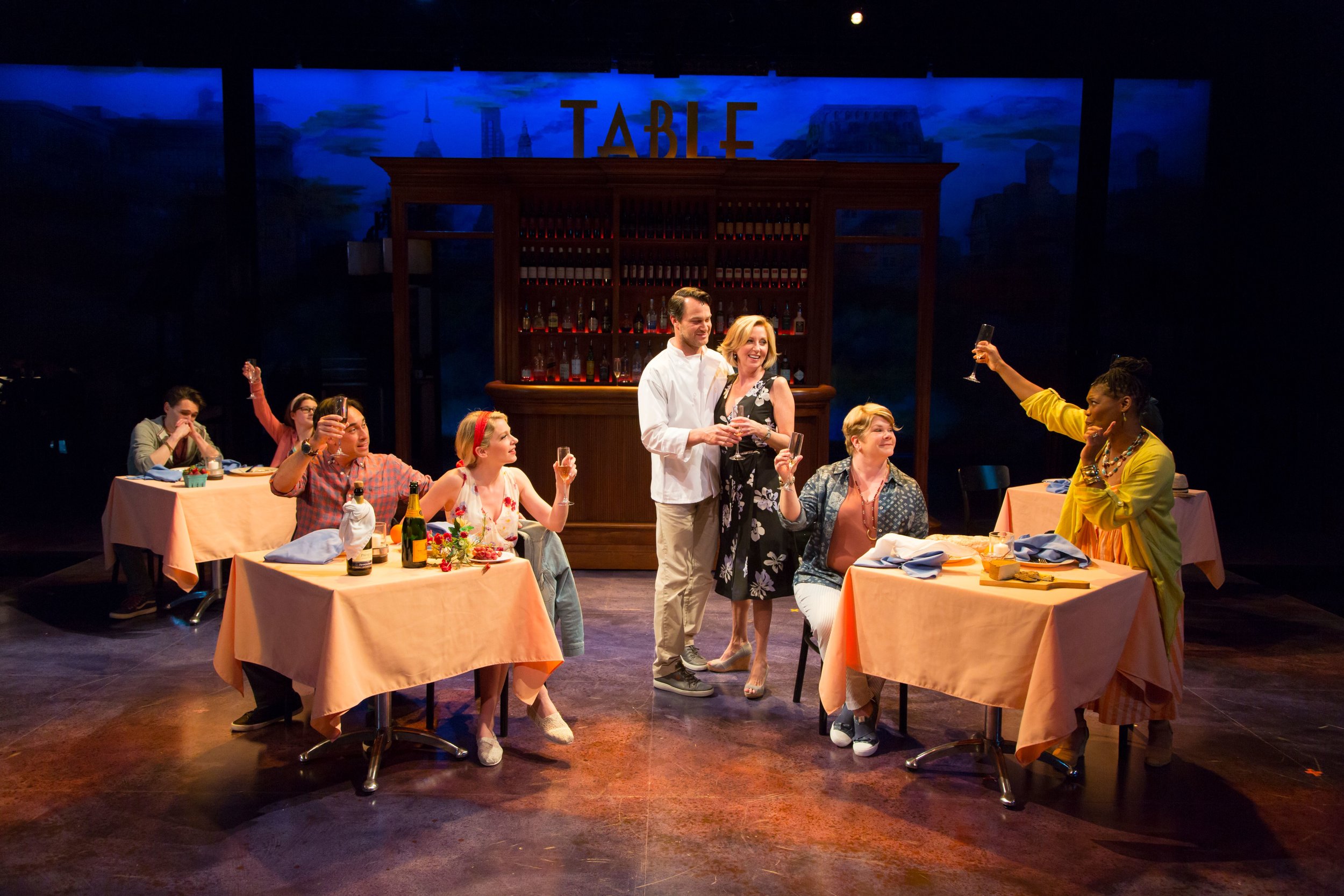Review of Manual Cinema: The End of TV, a World Premiere at the International Festival of Arts & Ideas
To see theater mimic TV is to see, in a sense, a reversal of history. Early televised programs were mostly performed live on a soundstage, caught by cameras. Manual Cinema, using live actors, shadow puppets, props, video cameras to relay live action onto a screen, and rendering both built and animated backgrounds, creates something neither like typical theater nor TV. It’s a hybrid method that tells its story almost entirely through images, leaving dialogue to the mouths of facsimiles of the incessant hucksters of commercial TV. Using startling effects and a thoughtful pace, The End of TV tells a poignant story—its sadness leavened by hopefulness and resilience—and makes its most compelling points indirectly. The show is magical theater, a hypnotic rendering of events and relations where the medium is a message about the medium.
While it’s odd to sit before live theater watching a screen, the relation between the scenes projected and their staging is a fascinating sort of drama in and of itself. This unusual, involving multi-media drama, a world premiere commissioned for this year's International Festival of Arts & Ideas, plays through June 22 at Yale's University Theatre.
The cast and musicians of The End of TV (photo: Judy Sirota Rosenthal)
Flo (Kara Davidson) is an aged woman living alone. Her only companionship is the programming on a TV station called QVC, which specializes in glib hucksterism, offering the usual panoply of items at what it claims are bargain prices: appliances, jewelry, chia pets. Flo is a compulsive buyer and at first our view of her is made comical by the tone of the QVC pitches. The facsimiles of hokey TV ads are amusing until they come to seem more malevolent. We realize that Flo is not simply lonely; she’s also getting a bit dotty, as she ignores alerts from her bank in favor of the latest item QVC offers. And she seems to believe TV is more real than reality.
Meanwhile, Louise is a young factory worker who loses her job when the plant closes. She takes a job with Meals on Wheels and, sure enough, encounters Flo as the last in a series of montages of the varied responses Louise receives. In Flo’s case, the visit becomes an intervention.
The main gist of the story is the coming together of two women who each has something to offer the other. Along the way, we get flashbacks that show a beloved daughter (Vanessa S. Valliere) for Flo and a beloved father (Jeffery Paschal) for Louise. There are also dream—or perhaps more properly dementia—sequences that show the kind of mental coping-mechanisms Flo’s imagination creates. The show’s title is relevant here, as the fantasies of those who found their lives’ greatest fascination in The Box are shown to be reflections of a bygone era, a sort of consumerist Golden Age where advertisements seemed benign and beloved, as in the Jolly Green Giant’s rosy ho-ho-ho.
The advent of the digital era is signaled by an entertaining sequence that not only creates the sights and sounds—and pace—of modem-driven internet access but also indicates the extent to which TV’s advertising has been surpassed by the shop and click of online buying.
There are other interesting subtexts as well, as for instance a flashback to Flo’s youth (including some very effective visuals) when the loss of man-power at home during World War II produced a rare early era of women in the workplace. And Louise’s story is told with a sureness of tone that is driven by the show’s almost alchemical mix of music and visuals. The musicians are onstage and the music they make creates a varied range of emotional resonances. The show’s creators—Kyle Vegter and Ben Kauffman—are also its composers and their vision is abetted by puppet designer Lizi Breit, director/storyboard artist Julia Miller, assistant director Sarah Fornace, and associate puppet designer/storyboard artist Drew Dir. All of the above are credited with adapting the show “for the screen,” which, in fact, they do. And it’s something to see.
Scenes and screens in The End of TV (photo: Judy Sirota Rosenthal)
Manual Cinema, as it were, takes back the notion of storytelling from the special-effects-laden spectacles of current films and creates its own special-effects version of how to tell stories live, as theater. It’s an interesting conceptual shift, playing both to contemporary audiences’ love of screens and to a certain childlike wonder at how we don’t really need words to tell and understand stories. The resources of mime and dumb-show are quite effectively mined by Manual Cinema to present a narrative that works its viewers’ imagination, intuition and empathy.
And these multi-tasking artists also provide, in their methods, a sustained consideration of how impersonal media depersonalize us and dilute rich histories. Somewhere along the way the kind of story-telling The End of TV seeks to sustain gave way to slick manipulations in the name of Product. In the sad but hopeful journey of Flo and Louise, Manual Cinema tries to restore a little faith in humanity, and in the art of rendering experience well.
The International Festival of Arts & Ideas
Manual Cinema: The End of TV
Story: Kyle Vegter and Ben Kauffman; Adapted for the Screen by Sarah Fornace, Julia Miller, Lizi Breit, Drew Dir, Kyle Vegter, Ben Kauffman; Director/Storyboard Artist: Julia Miller; Assistant Director: Sarah Fornace; Puppet Designer: Lizi Breit; Associate Puppet Designer/Storyboard Artist: Drew Dir; Lyrics and Music: Kyle Vegter and Ben Kauffman; Sound Designer: Kyle Vegter; Costume Designer: Mieka van der Pleog; Masks: Julia Miller; Lighting Designer: Claire Chrzan; Company Stage Manager: Shelby Glasgow; Production Manager/Sound Engineer: Mike Usrey
Puppeteers: Kara Davidson, Aneisa Hicks, Jeffrey Paschal, Vanessa Valliere
Musicians: Maren Celest, SFX, vocals; Deidre Huckabay, flutes, vocals; Ben Kauffman, guitar, keyboard, vocals; Lia Kohl, cello, vocals; Marques Toliver, violin, vocals
University Theatre
June 19-22, 2017























































